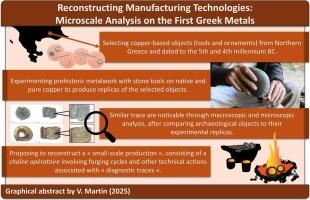重建制造技术:对第一批希腊金属的微观分析
IF 1.5
2区 历史学
0 ARCHAEOLOGY
引用次数: 0
摘要
公元前六世纪末至公元前五千年初,爱琴海及其周边地区的居民开始使用本地或纯金属(铜、金和银)制造工具和装饰品。新石器时代晚期/铜石器时代是一个交流和技术创新活跃的时期,为希腊最早的金属加工实践提供了理想的背景。到目前为止,有超过370个物体被记录为这艘飞船的证据。关于它们的制造过程的知识很少:无论是车间还是工具都没有得到安全的识别。然而,技术行为在物体上留下了痕迹,当物体没有被过度腐蚀时,这些痕迹仍然可见。在高达x250倍的数码显微镜(Dino-Lite)下,可以在它们的表面上区分它们。通过实验考古测试不同的工艺流程后,可以比较考古和实验的痕迹。这种方法已用于研究希腊北部(Sitagroi, Dikili Tash, Kryoneri和Dimitra)的铜发现。它允许我们在早期金属加工的背景下提出一套制造技术。本文章由计算机程序翻译,如有差异,请以英文原文为准。

Reconstructing manufacturing technologies: microscale analysis on the first Greek metals
At the end of the sixth and the beginning of the fifth millennium BC, inhabitants of the areas in and around the Aegean Sea started to use native or pure metals (copper, gold, and silver) to make tools and ornaments. As a dynamic period in terms of exchange and technical innovations, the Late Neolithic/Chalcolithic provided an ideal background for the first metalwork practices of Greece. More than 370 objects have been recorded so far as evidence of this craft. Knowledge about their manufacturing processes is scarce: neither workshops nor tools have been securely identified yet. However, technical actions have left traces on the objects, still visible when the object is not too corroded. These can be distinguished on their surface under digital microscope (Dino-Lite), up to a magnification of x250. After testing different technical processes through experimental archaeology, one can compare the archaeological and experimental traces. This approach has been conducted for the study of copper finds from northern Greece (Sitagroi, Dikili Tash, Kryoneri, and Dimitra). It allows us to suggest a set of manufacturing techniques integrated in the context of early metalworking.
求助全文
通过发布文献求助,成功后即可免费获取论文全文。
去求助
来源期刊

Journal of Archaeological Science-Reports
ARCHAEOLOGY-
CiteScore
3.10
自引率
12.50%
发文量
405
期刊介绍:
Journal of Archaeological Science: Reports is aimed at archaeologists and scientists engaged with the application of scientific techniques and methodologies to all areas of archaeology. The journal focuses on the results of the application of scientific methods to archaeological problems and debates. It will provide a forum for reviews and scientific debate of issues in scientific archaeology and their impact in the wider subject. Journal of Archaeological Science: Reports will publish papers of excellent archaeological science, with regional or wider interest. This will include case studies, reviews and short papers where an established scientific technique sheds light on archaeological questions and debates.
 求助内容:
求助内容: 应助结果提醒方式:
应助结果提醒方式:


